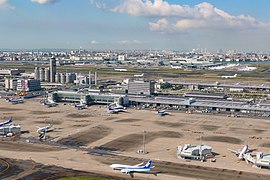
Back Tokio-Haneda Internasionale Lughawe Afrikaans مطار طوكيو هانيدا الدولي Arabic مطار طوكيو هانيدا الدولى ARZ Aeropuertu Internacional de Haneda AST Bandar Udara Haneda BAN হানেদা বিমানবন্দর Bengali/Bangla Aeroport Internacional de Tòquio Catalan Tokyo International Airport CEB Letiště Haneda Czech Maes Awyr Haneda, Tokyo Welsh
Haneda Airport 羽田空港 Haneda Kūkō | |||||||||||||||||||||||
|---|---|---|---|---|---|---|---|---|---|---|---|---|---|---|---|---|---|---|---|---|---|---|---|
 | |||||||||||||||||||||||
 | |||||||||||||||||||||||
| Summary | |||||||||||||||||||||||
| Airport type | Public | ||||||||||||||||||||||
| Owner/Operator | Ministry of Land, Infrastructure, Transport and Tourism | ||||||||||||||||||||||
| Serves | Greater Tokyo Area | ||||||||||||||||||||||
| Location | Ōta, Tokyo, Japan | ||||||||||||||||||||||
| Opened | August 15, 1931 | ||||||||||||||||||||||
| Hub for | |||||||||||||||||||||||
| Operating base for | |||||||||||||||||||||||
| Elevation AMSL | 6 m / 21 ft | ||||||||||||||||||||||
| Coordinates | 35°33′12″N 139°46′52″E / 35.55333°N 139.78111°E | ||||||||||||||||||||||
| Website | www | ||||||||||||||||||||||
| Maps | |||||||||||||||||||||||
 | |||||||||||||||||||||||
| Runways | |||||||||||||||||||||||
| |||||||||||||||||||||||
| Statistics (2023) | |||||||||||||||||||||||
| |||||||||||||||||||||||
Sources:[1] | |||||||||||||||||||||||
Haneda Airport (羽田空港, Haneda Kūkō) (IATA: HND, ICAO: RJTT), sometimes referred to as Tokyo-Haneda, is one of two international airports serving the Greater Tokyo Area, the other one being Narita International Airport (NRT). It serves as the primary base of Japan's two largest airlines, Japan Airlines (Terminal 1) and All Nippon Airways (Terminal 2), as well as RegionalPlus Wings Corp. (Air Do and Solaseed Air), Skymark Airlines, and StarFlyer. It is located in Ōta, Tokyo, 15 kilometers (9.3 mi) south of Tokyo Station. The facility covers 1,522 hectares (3,761 acres) of land.[2]
Haneda was the primary international airport serving Tokyo until 1978; from 1978 to 2010, Haneda handled almost all domestic flights to and from Tokyo as well as "scheduled charter" flights to a small number of major cities in East and Southeast Asia, while Narita handled the vast majority of international flights from further locations. In 2010, a dedicated international terminal, currently Terminal 3, was opened at Haneda in conjunction with the completion of a fourth runway, allowing long-haul flights during night-time hours.[3] Haneda opened up to long-haul service during the daytime in March 2014, with carriers offering nonstop service to 25 cities in 17 countries.[4] Since the resuming of international flights, airlines in Japan strategize Haneda as "Hub of Japan": providing connections between intercontinental flights with Japanese domestic flights, while envisioning Narita as the "Hub of Asia" between intercontinental destinations with Asian destinations.[5]
The Japanese government encourages the use of Haneda for premium business routes and the use of Narita for leisure routes and by low-cost carriers. However, the major full-service carriers may have a choice to fly to both airports.[6] Haneda handled 87,098,683 passengers in 2018; by passenger throughput, it was the third-busiest airport in Asia and the fourth-busiest in the world. It returned to the second-busiest airport in Asia after Dubai International Airport in 2023 in the Airports Council International rankings.[7] It is able to handle 90 million passengers per year following its expansion in 2018. With Haneda and Narita combined, Tokyo has the third-busiest city airport system in the world, after London and New York.
In 2020, Haneda was named the second-best airport after Singapore's Changi Airport[8] and the World's Best Domestic Airport.[9] It maintained its second place in Skytrax’s world's top 100 airports for 2021 and 2022, in-between Qatar's Hamad International Airport and Singapore's Changi Airport, and maintaining its best Domestic Airport title from the previous year.[10][11]
- ^ "stats".
- ^ "Haneda Airport Facts". dobohaku.com. August 2016. Retrieved October 17, 2023.
- ^ "Tokyo Haneda's new runway and terminal welcome more international services; almost 50 domestic routes served". anna.aero airline route news & analysis. 20 October 2010. Archived from the original on 7 November 2010. Retrieved 4 November 2010.
- ^ 羽田空港の国際線拡大、欧州・東南アジア便が就航. Nihon Keizai Shimbun. 30 March 2014. Archived from the original on 15 December 2018. Retrieved 31 March 2014.
- ^ 藤中 潤 (2019-11-20). "羽田発着枠拡大、ハワイ路線移管のJALが意識するANAの好調" (in Japanese). Nikkei Business.
- ^ "Peach to offer Tokyo-Taipei service out of Haneda Airport". Nikkei. 16 January 2015. Archived from the original on 20 January 2015. Retrieved 19 January 2015.
The [transport] ministry's strategy has been to steer budget carriers, used mainly for leisure travel, toward Narita Airport. Major airlines, used chiefly for business trips, are encouraged to fly out of Haneda.
- ^ Josephs, Leslie (2024-04-15). "World's busiest airports show surge in international travel. Here are the rankings". CNBC. Retrieved 2024-04-15.
- ^ "The World's Best Airports in 2020 are announced". Skytrax. 2020-05-11. Archived from the original on 2020-05-22. Retrieved 2020-05-15.
- ^ Cripps, Karla. "The world's best airports for 2020, according to Skytrax". CNN. Archived from the original on 2020-05-14. Retrieved 2020-05-15.
- ^ "The World's Best Airports in 2020 are announced". Skytrax. 2021-08-05. Archived from the original on 2021-09-08. Retrieved 2021-09-08.
- ^ Cripps, Karla. "The world's best airports for 2020, according to Skytrax". CNN. Archived from the original on 2020-05-14. Retrieved 2020-05-15.
© MMXXIII Rich X Search. We shall prevail. All rights reserved. Rich X Search


